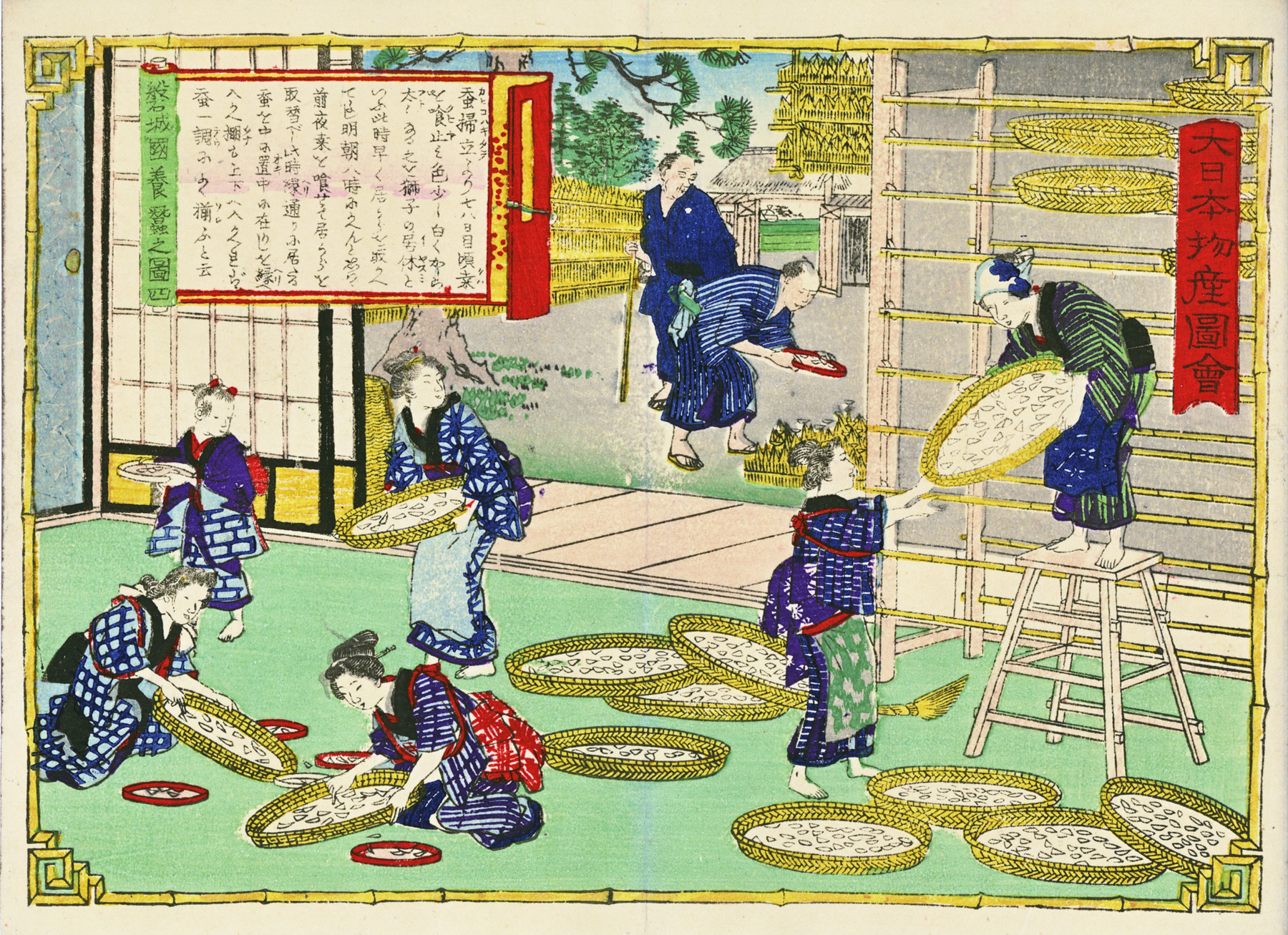About This Print
One of 118 prints in the series Dai Nippon Bussan Zue (Products of Greater Japan), issued in August 1877 to coincide with the opening of Japan’s first National Industrial Exposition (Naikoku Kangyō Hakurankai) held in Tokyo’s Ueno Park.
The six prints in the series depicting silkworm culture are:
Silkworm Culture in Hida Province (figure 2) 飛騨国 養蚕之図 二
Silkworm Culture in Shimotsuke Province (figure 3) 下野国 養蠶國 三
Silkworm Culture in Rikuzen Province (figure 5) 陸前国 養蠶図 五
Silkworm Culture in Rikuchū Province (figure 6) 陸中国 養蚕之図 六
Cultivating Wild Silkworms in Tajima Province 但馬国 野蚕養之図
Iwaki (磐城国, Iwaki-no kuni) is a former province of Japan established in Meiji Era. It was cut out of Mutsu Province and corresponded to the eastern part of modern Fukushima Prefecture. Its population in 1872 was 348,608.3
Notes:
[備考]中判 横 錦絵 画工:歌川広重3 広重筆 版元:大倉孫兵衛 主題内容:産業・技術 物産絵 磐城 人名その他:蚕棚 蚕 籠
Scroll:
Iwaki (磐城国, Iwaki-no kuni) is a former province of Japan established in Meiji Era. It was cut out of Mutsu Province and corresponded to the eastern part of modern Fukushima Prefecture. Its population in 1872 was 348,608.3
Scroll Inscription
Source: National Museum of Japanese History http://www.rekihaku.ac.jp/up-cgi/getdocrd.pl?tn=1556&ti=0&h=./history/w11288752628_28652&ch=2&p=param/nisikie/db_param&o=1551&k=50&l=&sf=0&so=Notes:
[備考]中判 横 錦絵 画工:歌川広重3 広重筆 版元:大倉孫兵衛 主題内容:産業・技術 物産絵 磐城 人名その他:蚕棚 蚕 籠
Scroll:
「蚕掃立より七八日目頃桑を喰止み色少し白くかしら太くなる 之を獅子の居休といふ 此時早く居からを取かへてよし 明朝八時にかへんと思はゝ 前夜桑を喰 せて居からを取替べし 此時縁通りに居たる蚕を中に置 中に在りしを縁へ入かへ 棚も上下へ入かへれば 蚕一調によく揃ふと云」
Multiple Editions (Variant Printings)
At least three variant printings (editions) were made of this series. Each variant printing uses a different colored cartouche containing the series' title, either red, green or rainbow-colored. Different colored borders were also used and variances in the use of colors and shading are present in the three editions.
1 Website National Diet Library https://www.ndl.go.jp/exposition/e/s1/naikoku1.html2 "Sericulture and the Origins of Japanese Industrialization", Tessa Morris-Suzuki, appearing JSTOR, Vol. 33, No.1, January 1992, p. 1-2-103; p. 121.
3 Wikipedia http://en.wikipedia.org/wiki/Iwaki_Province_%281868%29
latest revision:
3 Wikipedia http://en.wikipedia.org/wiki/Iwaki_Province_%281868%29
Print Details
| IHL Catalog | #372 |
| Title or Description | Depiction of Silkworm Culture in Iwaki Province (figure 4) 磐城国 養蚕之図 四 |
| Series | Dai Nippon Bussan Zue 大日本物産図会 (Products of Greater Japan) |
| Artist | Utagawa Hiroshige III (1842–1894) |
| Signature | no signature visible |
| Seal | none |
| Publication Date | 1877 (Meiji 10) |
| Publisher | Ōkura Magobei 大倉孫兵衛 (Kin'eido; 1843-1921) [Marks: pub. ref. 627] |
| Impression | good |
| Colors | excellent |
| Condition | good - vertical centerfold |
| Genre | nishiki-e; kaika-e |
| Miscellaneous | |
| Format | chuban |
| H x W Paper | 6 7/8 x 9 1/4 in. (17.5 x 23.5 cm) |
| H x W Image | 6 1/4 x 8 7/8 in. (15.9 x 22.5 cm) |
| Literature | |
| Collections This Print | Hagi Yamaguchi Prefectural Art Museum Urakami system: U02986; National Museum of Japanese History H-22-1-30-7-32 |
3/26/2020


